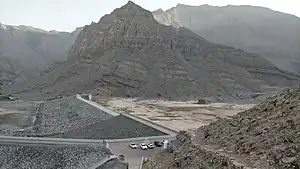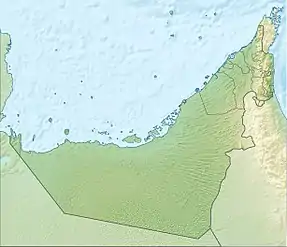Wadi Ghalilah
The Wadi Ghalilah[1] is a valley or dry river, with intermittent flow, which flows almost exclusively during the rainy season, located in the northeast of the United Arab Emirates, in the Emirate of Ras al Khaimah.
| Wadi Ghalilah | |
|---|---|
 Wadi Ghalilah Dam | |
 | |
| Location | |
| Country | United Arab Emirates |
| Emirate | Ras al-Khaimah |
| Physical characteristics | |
| Source | Wadi Ghalilah Dam. Confluence of the Wadi Litibah and the Wadi Barut. Al Hajar Mountains |
| • elevation | 140 m (460 ft) |
| Mouth | South of the city of Ghalilah, on the Persian Gulf |
• coordinates | 25°59′12.3″N 56°04′01.8″E |
• elevation | 0 m (0 ft) |
| Length | 10 km (6.2 mi) |
| Basin size | 76.32 km2 (29.47 sq mi) |
| Basin features | |
| River system | Wadi Ghalilah |
| Tributaries | |
| • left | Wadi Litibah, Wadi Barut, Wadi Al Yaham, Wadi Halhal |
| • right | Wadi Khabb, Wadi Al Khiway |
It is formed from the confluence of its two main tributaries: the Wadi Litibah and the Wadi Barut. At the point of confluence, a 420-meter-wide and 6-meter-high dam was built in 2001, called the Wadi Ghalilah Dam,[2] intended mainly to feed underground water resources and reduce damage from eventual floods.[3]
Course
Starting from the dam, the Wadi Ghalilah follows its course from east to west, with a gentle and almost flat slope, a decline of 140 m in a distance of 10 km is distributed until its mouth in the Persian Gulf.
Throughout the wide valley that it forms, there are farms, small villages, scattered houses, and in recent years several urbanizations with chalets and luxurious residences have sprung up. According to the data collected in the Wadi Ghalilah Dam construction project, there are currently 1,100 houses and 188 farms in the area of this wadi.[4]
The final stretch of the wadi runs through the controversial industrial zone of Khor Khwair, which is home to several of the largest quarries in the UAE, four cement factories, a gas processing plant, manufacturing facilities of marble and concrete, and other similar industries, with great environmental impact.[5]
Toponymy
Alternative Names: Wadi Ghalila, Wadi Ghalilah, Wādī Ghalīlah.
The names of this wadi and its tributaries was recorded in the documentation and maps produced between 1950 and 1960 by the British Arabist, cartographer, army officer and diplomat Julian F. Walker,[6] during the work carried out to establish borders between what were then called Trucial States, later completed by the Ministry of Defense (UK), on 1:100,000 scale maps published in 1971.[7]
Previously, there are multiple references to Ghalilah in the encyclopedic work published by the diplomat and historian John Gordon Lorimer (1870-1914), in the chapters devoted to the detail and description of the different tribes that inhabited the coast and the interior of the territory of the Musandam Peninsula.[8]
It also appears, with the spelling Wādī Ghalīlah, in the National Atlas of the United Arab Emirates.[9]
In the political and administrative organization of the Emirate of Ras al Khaimah, the name of the main wadi is frequently used as an identifying element of the entire territory covered by its drainage basin.
In the case of Wadi Ghalilah, this drainage sub-basin is very large (76.32 km2),[10] comprising numerous towns, villages and farms widely scattered throughout its valleys and mountains. Naturally, it also includes all the ravines and tributaries of the main wadi.
The same denomination is also used for postal purposes.
For this reason, the mistake of considering that this is the only name that corresponds to all the different wadis, and even to some population centers in this region, is widespread, frequently ignoring the true name of each of these places.
This has contributed to the tributaries of the Wadi Ghalilah: Wadi Litibah, Wadi Barut, Wadi Halhal and Wadi Khabb being sometimes incorrectly called Wadi Ghalilah.[11]
Geology and population
The geographical area of Wadi Ghalilah, highly valued in geological studies of marine sediments,[12] it was inhabited by tribes was historically populated by the semi-nomadic Shihuh tribe, section of Bani Shatair (Arabic: بني شطير), distributed in the tribal areas of Maḩābīb,[13] Raḩabah,[14] Banī Sā‘ad [15] and Hammad;[16] and also by the section of Bani Hadiyah (Arabic: بني هدية), which occupied, among other territories, the tribal area of Ahl Sayḩ.
References
- "Mindat.org - Wādī Ghalīlah |". www.mindat.org. Retrieved 2023-05-10.
- "AQUASTAT - FAO's Global Information System on Water and Agriculture | www.fao.org/". Retrieved 2023-05-10.
- "Watch: UAE wadis flood, dam overflows after heavy rains batter country - Waters were also roiling in Wadi Ghalilah's dam |". www.khaleejtimes.com. Retrieved 2023-05-10.
- "Wadi Ghalilah - Insight: UAE builds dam worth Dh250m |". www.Gulfnews.com. Retrieved 2023-05-10.
- "Wadi Ghalilah - Funds managing $2 trillion urge cement makers to act on climate impact |". www.arabnews.com. Retrieved 2023-05-10.
- Julian Fortay Walker (1958) - Sketch map drawn by Julian Walker for boundary delimitation: Ras Al Khaimah - The National Archives, London, England
- "Map of Trucial States, Muscat and Oman - Rams - Scale 1:100 000 - Published by D Survey, Ministry of Defence, United Kingdom (1971) - Edition 3-GSGS - The National Archives, London |". www.agda.ae. Retrieved 2023-05-10.
- Gazetteer of the Persian Gulf. Vol II. Geographical and Statistical. JG Lorimer. 1908', British Library: India Office Records and Private Papers, IOR/L/PS/20/C91/4, in Qatar Digital Library <https://www.qdl.qa/archive/81055/vdc_100000000884.0x00014b>
- Jāmiʻat al-Imārāt al-ʻArabīyah al-Muttaḥidah. Geoprojects (U.K.) Ltd., The National atlas of the United Arab Emirates, Al Ain : United Arab Emirates University - 1993
- United Arab Emirates - Water conservation strategy - Eng Salim Akram. Director of Dams Department. Dr Abdelazim Ebraheem. Water Resources Evaluation Consultant - Natural Disaster Science and Mitigation Engineering: Ministry of Environment and Water UAE - 2021
- Searle, Mike. Geology of the Oman Mountains, Eastern Arabia. ISBN 978-3-030-18453-7 - Germany: Springer International Publishing, 2019
- "Johannes Greiff, Master's thesis - Dissertations in Geology at Lund University - Archives for the aftermath of the end- Triassic mass extinction - Petrographic descriptions and interpretations of the Wadi Ghalilah samples". Geologiska institutionen Lunds universitet. 2021. Retrieved May 10, 2023.
- "Mindat.org - Maḩābīb |". www.mindat.org. Retrieved 2023-05-10.
- "Mindat.org - Raḩabah |". www.mindat.org. Retrieved 2023-05-10.
- "Mindat.org - Banī Sā'ad |". www.mindat.org. Retrieved 2023-05-10.
- "Geoview.info - Hammad |". www.mindat.org. Retrieved 2023-05-10.
External links
- Ibrahim Al-Shehhi - Snapshots of the flow of Wadi Ghalilah in Ras Al Khaimah, 13-01-2016 (YouTube)
- Ibrahim Al-Shehhi - Aerial photography of farms in the Ghalilah area in Ras Al Khaimah, 14-01-2020 (YouTube)
![]() Media related to Wādī Ghalīlah (UAE) at Wikimedia Commons
Media related to Wādī Ghalīlah (UAE) at Wikimedia Commons